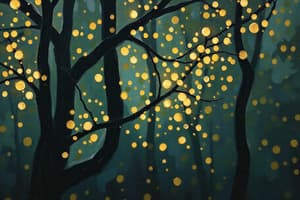Podcast
Questions and Answers
What does the absolute threshold refer to in sensation and perception?
What does the absolute threshold refer to in sensation and perception?
- The smallest level of stimulus that can be detected half the time. (correct)
- The intensity level that is always noticeable.
- The average response to a sensory stimulus.
- The maximum level of stimulus that can be ignored.
What specialized ability have humans evolved to recognize that is distinct from other organisms?
What specialized ability have humans evolved to recognize that is distinct from other organisms?
- Recognizing faces through the FFA. (correct)
- Noticing movement in peripheral vision.
- Detecting sound frequencies.
- Identifying colors.
In what scenario would you detect a stimulus that exemplifies the absolute threshold?
In what scenario would you detect a stimulus that exemplifies the absolute threshold?
- Seeing the faint light of a distant star. (correct)
- Feeling a gentle breeze on your face.
- Smelling food being cooked from afar.
- Hearing a conversation in a crowded room.
What process occurs when you interpret a rustling in the bushes based on past experiences?
What process occurs when you interpret a rustling in the bushes based on past experiences?
During the perception process, what typically informs our attention to certain stimuli over others?
During the perception process, what typically informs our attention to certain stimuli over others?
What is the absolute threshold for sight?
What is the absolute threshold for sight?
What does the term 'Just Noticeable Difference' (JND) refer to?
What does the term 'Just Noticeable Difference' (JND) refer to?
Which of the following demonstrates the Stroop Effect?
Which of the following demonstrates the Stroop Effect?
Which absolute threshold corresponds to the sense of taste?
Which absolute threshold corresponds to the sense of taste?
What type of processing is required to name the ink color in the Stroop Effect?
What type of processing is required to name the ink color in the Stroop Effect?
Which threshold is described as the smallest detectable stimulus change?
Which threshold is described as the smallest detectable stimulus change?
The tick of a watch is identified as which type of threshold?
The tick of a watch is identified as which type of threshold?
What example illustrates the absolute threshold for touch?
What example illustrates the absolute threshold for touch?
Flashcards
Transduction
Transduction
Process of converting physical stimuli into neural signals.
Top-down reasoning
Top-down reasoning
Interpreting sensory information based on prior knowledge.
Fusiform Face Area (FFA)
Fusiform Face Area (FFA)
Brain region specialized for recognizing faces.
Absolute Threshold
Absolute Threshold
Signup and view all the flashcards
Evolution of perception
Evolution of perception
Signup and view all the flashcards
Sight Absolute Threshold
Sight Absolute Threshold
Signup and view all the flashcards
Hearing Absolute Threshold
Hearing Absolute Threshold
Signup and view all the flashcards
Difference Threshold (JND)
Difference Threshold (JND)
Signup and view all the flashcards
Smell Absolute Threshold
Smell Absolute Threshold
Signup and view all the flashcards
Taste Absolute Threshold
Taste Absolute Threshold
Signup and view all the flashcards
Stroop Effect
Stroop Effect
Signup and view all the flashcards
Automatic Processing
Automatic Processing
Signup and view all the flashcards
Study Notes
Sensation & Perception Introduction
- The session covers sensation and perception, focusing on key concepts like absolute and difference thresholds.
- The agenda includes a warm-up exercise, a Stroop Effect activity, and an exit ticket.
Warm-up Exercise
- Instructions: Imagine walking through a forest and hearing a rustle in the bushes. Use top-down reasoning based on past experiences to predict what might be there. Describe the transduction process happening.
- Expected response: Needs to be in 3-4 sentences.
Perception & Evolution
- We perceive what we've evolved to perceive.
- Different organisms have evolved different sensory systems. (Examples: catfish whiskers, shark movement sensors, grasshopper ears, snake heat sensors)
Human Visual Perception
- Humans have evolved specialized abilities, including a specific brain area (FFA) for recognizing faces unlike other organisms.
Stroop Effect Activity
- The Stroop Effect demonstrates interference between automatic (fast processing) and controlled cognitive processes (more effort).
- Example: Reading words printed in different colors. (Example activity presented)
- The activity aims to illustrate the interference phenomenon by having individuals read the color words themselves and to highlight how the cognitive process can be impacted by automatic processes.
Absolute Threshold
- The smallest level of stimulus detectable half the time.
- Threshold example: A candle flame 30 miles away, or very soft sounds, or a very small amount of taste or smells.
Difference Threshold (JND)
- The smallest detectable difference between two stimuli.
- JND examples: A change in volume or a variation in light.
Change Blindness
- The tendency to miss changes in the immediate visual environment.
- Example: A video example is presented for the illustration.
- Examples of Change Blindness: Both minor and major changes, may be missed.
Studying That Suits You
Use AI to generate personalized quizzes and flashcards to suit your learning preferences.




